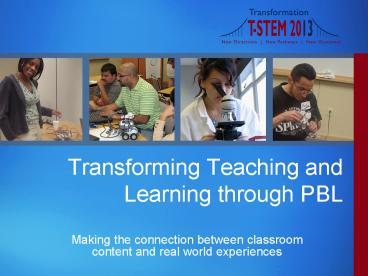Transforming Teaching and Learning through PBL - PowerPoint PPT Presentation
1 / 17
Title:
Transforming Teaching and Learning through PBL
Description:
Equipped to support spontaneous questioning as well as planned ... Supportive of teaching in multiple modalities ... Resources. Buck Institute for Education ... – PowerPoint PPT presentation
Number of Views:28
Avg rating:3.0/5.0
Title: Transforming Teaching and Learning through PBL
1
Transforming Teaching and Learning through PBL
- Making the connection between classroom content
and real world experiences
2
Who we are ..
- Transformation 2013 T-STEM Center
- Collaborative project between Region XIII, 20 and
our partners. - Stacy Avery, Coordinator
www.transformation2013.org
3
What makes PBL effective in teaching and learning
..
- Active and engaging lessons
- Equipped to support spontaneous questioning as
well as planned investigation - Center for innovation and invention
- Supportive of teaching in multiple modalities
- Serves students with a variety of learning styles
and abilities
4
Attributes of a STEM student
- Problem-solvers
- Innovators
- Self-reliant
- Logical thinkers
- Technologically literate
- Sense of identity
5
Engineering Design Process
6
(No Transcript)
7
Characteristics of PBL
- Learning is student centered
- Instructor is coach/facilitator
- Students work in small groups to solve problems
- Student assessment is enhanced by self/peer
assessment - Relevant to student world
- Flexible environment of varying lengths
8
Questions to Ask Ourselves
- Are our students critical thinkers and problem
solvers? - Are our students globally aware?
- Are our students self-directed?
- Are our students good collaborators?
9
Questions to Ask Ourselves
- Are our students information and technology
literate? - Are our students flexible and adaptable?
- Are our students innovative?
- Are our students effective communicators?
10
A Model forPlanning the PBL
11
Critical Components
- Authenticity
- Driving Question
- Academic Rigor
- Grounded in content and TEKS
- Structured model for lesson development (5E)
- Applied Learning
- Authentic and applicable to real world
- Active Exploration
- Inquiry into critical questions
- Assessment
- End result, authentic assessment
12
Classroom Roles
- Teacher
- Monitoring learning
- Probing/challenging students thinking
- Managing group dynamics
- Asking about thinking
- Keeping the process moving
- Student
- Active participant
- Engaged
- Constructing meaning
- Works collaboratively
- Draws on prior knowledge
- Solves problems
- Draws conclusions
13
Planning ToolHow to create a PBL lesson
- Step 1 Begin with the end in mind
- Step 2 Craft the Design Challenge
- Step 3 Map the Design Challenge
- Step 4 Plan the Design Challenge (5E Lesson
Model) - Step 5 Plan the assessment
- Step 6 Create Rubrics
14
Step 1 Begin with the End in Mind
- Summarizing big ideas
- Identifying the TEKS/SEs
- Identify the Key performance indicators
- 21st Century Skill
- Stem Careers
15
Step 2Crafting the Design Challenge
- State the essential question
- Outcome
- Content
- Focus for inquiry
- Problem statement
16
Step 3Map the Design Challenge
- Major Products
- Task analylsis
- What students need to know
- What is already learned
- What will be taught prior
- What will be taught during
17
Step 4Planning the PBL
- 5E
- Engage
- Explain
- Explore
- Elaborate
- Evaluate
18
Sample PBLscreated by teacher for teachers
19
Sample PBLs
- Algebra I
- Ins and Outs of Functions
- Geometry-
- Simply Logical, My Dear Watson
- Biology
- Genetics Cellular Reproduction
- Physics
- Momentum
20
What makes a good problem
- Students must make or do something authentic
- Students should have access to the same kinds of
tools/technology adults use - Student work and thinking should be
21
Driving Questions
- Are.
- Provocative
- Open ended
- At the heart of the discipline
- Challenge
22
Planning
- Plan which content standards will be addressed
while answering the question. - Involve students in the questioning, planning,
and project-building process. - Teacher and students brainstorm activities that
support the inquiry.
23
Timelines
- Teacher and students design a timeline for
project components. - Set benchmarks.
- Keep it simple and age-appropriate.
24
Facilitating
- Monitor and facilitate the process.
- Mentor the process.
- Utilize rubrics.
25
Assess Progress
- Make the assessments authentic.
- Know authentic assessments will require more time
and effort from the teacher. - Vary the type of assessments used.
26
Evaluate
- Take time to reflect, individually and as a
group. - Share feelings and experiences.
- Discuss what worked well.
- Discuss what needs change.
- Share ideas that will lead to new inquiries, thus
new projects.
27
Resources
- Buck Institute for Education
- www.bie.org
- George Lucas Education Foundation
- www.edutopia.org
- Classroom Instruction that Works
- Marzano, Robert and Debra Pickering, Jane
Pollack. Classroom Instruction that Works.
Alexandria ASCD, 2001. - What Works in Schools Translating Research into
Action - Marzano, Robert. What Works in Schools
Translating Research into Action. Alexandria
ASCD, 2003. - Illinois Math and Science Academy
- http//www2.imsa.edu/
- Brain Pop
- http//www.brainpop.com/necc2008
28
Contact us
- www.transformation2013.org
- Stacy Avery, Coordinator
- stacy.avery_at_esc13.txed.net
- Cassandra Ricks, Math, STEM Specialist
- cassandra.ricks_at_esc13.txed.net
- Julianne Webb, Science, STEM Specialist
- julianne.webb_at_esc20.net































